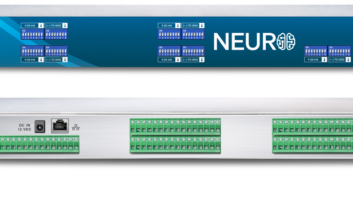Alan Shea is an SBE-certified engineer working with HCJB. He recalls us mentioning a UPS that is not frequency-sensitive, though costly. That earlier Workbench article concluded with the statement that we can’t all afford computer-controlled generators.

Fig. 1: A standard genset fuel pump … Alan says these are more affordable than most people think. He has installed a number of speed controllers and actuators from Governors America Corp. over the last decade and has been pleased not only with the quality but their reasonable cost.
If your diesel genset uses one of the most common Stanadyne injection fuel pumps, seen in Fig. 1, you can install an electronic governor for around $650. Alan has installed them in just a couple of hours, most of that spent in wiring.
The GAC ADC100 actuator for Stanadyne pumps is approximately $290. A magnetic pickup for speed sensing off the flywheel ring gear is around $70.
The completed new pump is shown in Fig. 2.
Governors America makes actuators that will fit almost any fuel delivery system, diesel or gaseous. A caveat is that Alan has worked only with diesel generators; he doesn’t have experience with their systems for gaseous fuels. However, GAC can give you good advice on the best route to integrate an actuator on your genset.
The controller with which Alan has the most experience is the ESD5500E (approximately $300), which also appears to be one of the most popular. It’s only about $100 more than the low-end ESD2100 or ESD2200. It has more flexibility for dynamics adjustments, speed-ramping to minimize smoke and pollution and an auxiliary input for speed adjustment or synchronizing if you later want to add that feature.
He’s used both and prefers the dynamic adjustments of the 5500E, but the 2200 works fine for tight budget installations.
(click thumbnail)
Fig. 2: … has the fuel-shutoff solenoid replaced with a GAC governor actuator for speed control. Alan has been working for three years with Liberia’s Radio ELWA (“Eternal Love Winning Africa”). He has used the ESD5500E on three of their gensets. Alan has watched it hold the speed to within one RPM despite a varying load and parallel operation.
Alan adds that generators are critical in Liberia; there has been no commercial electricity in the country since the infrastructure was destroyed by war in 1990!
A key element to the multi-genset project is the InteliGen genset controller.
Alan learned about this device from the folks at GAC. The InteliGen, made in the Czech Republic by ComAp, provides genset control, monitoring and logging, along with automatic startup, synchronizing, load-sharing and shutdown of parallel gensets. For standby installations, as found in the United States, the InteliGen can back-synchronize to the utility for no-break transfer of power.
A basic standby controller, the InteliLite AMF, is about $600; the InteliCompact NT for synchronizing to utility power is a little over twice that.
A benefit to the InteliGen product is that they are ideal for retrofit or upgrading an older control system on an existing genset. Fig. 3 shows the electronic governor controllers, and Fig. 4 shows the control panel.


Fig. 3: Wiring to the governor controllers is straightforward.
Radio World contributor Mark Persons adds that many gensets need this kind of control. However, that is just half of the equation. The other part is cleanliness of the power delivered by the generator. You hope for 6 percent or less harmonic distortion of the generated waveform, but some gensets put out something that looks like a tilted square wave. This is bad news for any UPS units connected to it.
* * *
Charles “Buc” Fitch, P.E., likes to rehabilitate vintage equipment. He recently worked on a Collins 900 Series FM modulation monitor.
The device, built as only a Collins could be built, has several laudable assets including measuring just about every necessary and desirable factor in the FM stereo signal.
Besides the dried-out capacitor problem you’ll find in any gear that runs 24/7 in a hot rack, this unit had a unique issue involving stability of the pulse forming and counting section.

Fig. 4: The Inteligen control panel after installation.
The designers used 2N3638A transistors in this section; though they are garden-variety NPN silicon transistors similar to the 2N2222, they are supposed to be centered on 30 HFE. It appears that this is actually a near-critical value. Buc had to go through a quantity of NPN transistors of various numbers until he found four that were near 30 HFE. This finally got the circuits to calm down.
It turns out that a couple of components in this circuit area are “hand-selected on the test line,” so the circuit is actually as critical as it appears.
This discovery reminds us of the only snag in restoring older test equipment: Test/monitoring gear is useless if it is not accurate and stable.
John Bisset marked his 40th year in radio in broadcasting recently. He works for Tieline Technology and is a past recipient of the SBE’s Educator of the Year Award. Reach him at [email protected] or (603) 472-5282. Faxed submissions can be sent to (603) 472-4944.
Submissions for this column are encouraged and qualify for SBE recertification credit.












